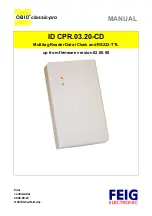
Pin
Signal
Function
–
–
Screen
M12 adapter cable on D-Sub, e.g. part no. 2055419 (2 m)
Adapter cable (female connector, M12, 17-pin, A-coded/male connector, D-Sub-HD, 15-pin)
6
1
10
5
11
15
Figure 8: Male connector, D-Sub-HD, 15-pin
Pin assignment of the “Power/Serial data/CAN/I/O” connection (D-Sub-HD)
Pin
Signal
Function
1
V
S
Supply voltage
2
RxD (RS-232), Aux
Aux interface (receiver)
3
TxD (RS-232), Aux
Aux interface (sender)
4
Sensor 2
Digital input 2
5
GND
Ground
6
RD+ (RS-422/485), Host
Host interface (r)
7
RD– (RS-422/485), Host
RxD (RS-232), Host
Host interface (receiver–)
8
TD+ (RS-422/485), Host
Host interface ()
9
TD– (RS-422/485), Host
TxD (RS-232), Host
Host interface (sender-)
10
CAN H
CAN bus (IN/OUT)
11
CAN L
CAN bus (IN/OUT)
12
Result 1
Digital output 1
13
Result 2
Digital output 2
14
Sensor 1
Digital input 1
15
SensGND
Digital input ground
Ethernet connection
1
4
3
2
Figure 9: M12 female connector, 4-pin, D-coded
Pin assignment of the “Ethernet” connection
Pin
Signal
Function
1
TD+
2
RD+
R
3
TD–
Sender–
4
RD–
Receiver–
6
Commissioning and configuration with computer (Windows
PC)
Adaptation of the device parameters to the application as well as diagnostics in
the event of malfunctions take place as default with the SOPAS ET configuration
software.
6.1 Installing and starting the configuration software
1.
Download and install the latest version of the SOPAS ET configuration soft‐
ware, as well as the current device description files (
*.sdd
):
. In this case, select the “Complete” option as sug‐
gested by the installation wizard. Administrator rights may be required on the
computer (PC) to install the software.
2.
Start the “SOPAS ET” program option after completing the installation. Path:
Start > Programs > SICK > SOPAS ET Engineering Tool > SOPAS.
3.
Establish communication between SOPAS ET and device with the automati‐
cally launching wizard. To do so, select the RFU630 under the devices avail‐
able depending on the connected communication interface, e.g. in the Ether‐
net (default Ethernet address: IP address: 192.168.0.1, subnet mask:
255.255.255.0). SOPAS ET establishes communication with the device and
loads the associated device description file. The
Quickstart
tab opens.
6.2 Detecting a transponder in Quickstart mode
1.
Bring one or more standards-compliant UHF transponders into the working
range of the integrated antenna of the device and/or into the working area of
the external antenna(s). The UII/EPC of the individual transponders must be
differentiated so that the device can detect several transponders.
2.
Click the
Start
button on the
Quickstart
tab of SOPAS ET. SOPAS ET generates
an automated read cycle and lists the detected transponders one after
another in the Quickstart window.
Figure 10: SOPAS ET display of the detected transponders in the
Quickstart
win‐
dow
Feedback about transponder detection in the UHF field
In Quickstart mode, default lighting behavior of the process feedback LEDs indi‐
cates whether a UHF field is present and whether the device has detected
transponders. The process feedback LED is in the center of the device front plate,
and in this case, lights up blue.
Process feedback LED
LED status
Status
At half brightness:
Permanently on
UHF field available, no transponder in the
field
At full brightness:
Flashing slowly (f = 1.25 Hz)
1 transponder in field
Flashing quickly (f = 2.5 Hz)
2 transponders in field
Flashing faster (f = 5 Hz)
More than 2 transponders in field
NOTE
Quickstart mode is not intended to be used during normal operation. For
operational use, set a read cycle using the object trigger control in SOPAS ET.
6.3 Accessing the data on a transponder
1.
In order to access the memory area of a transponder, click the
Stop
button in
Quickstart
.
2.
Highlight the desired transponder (click it with the mouse).
3.
Click the
Transponder Access
button. The
Transponder Management Access
tab dis‐
plays the content of the selected transponder.
8016526/160H/2019-11-14/en
RFU630-131xx | SICK
5




























